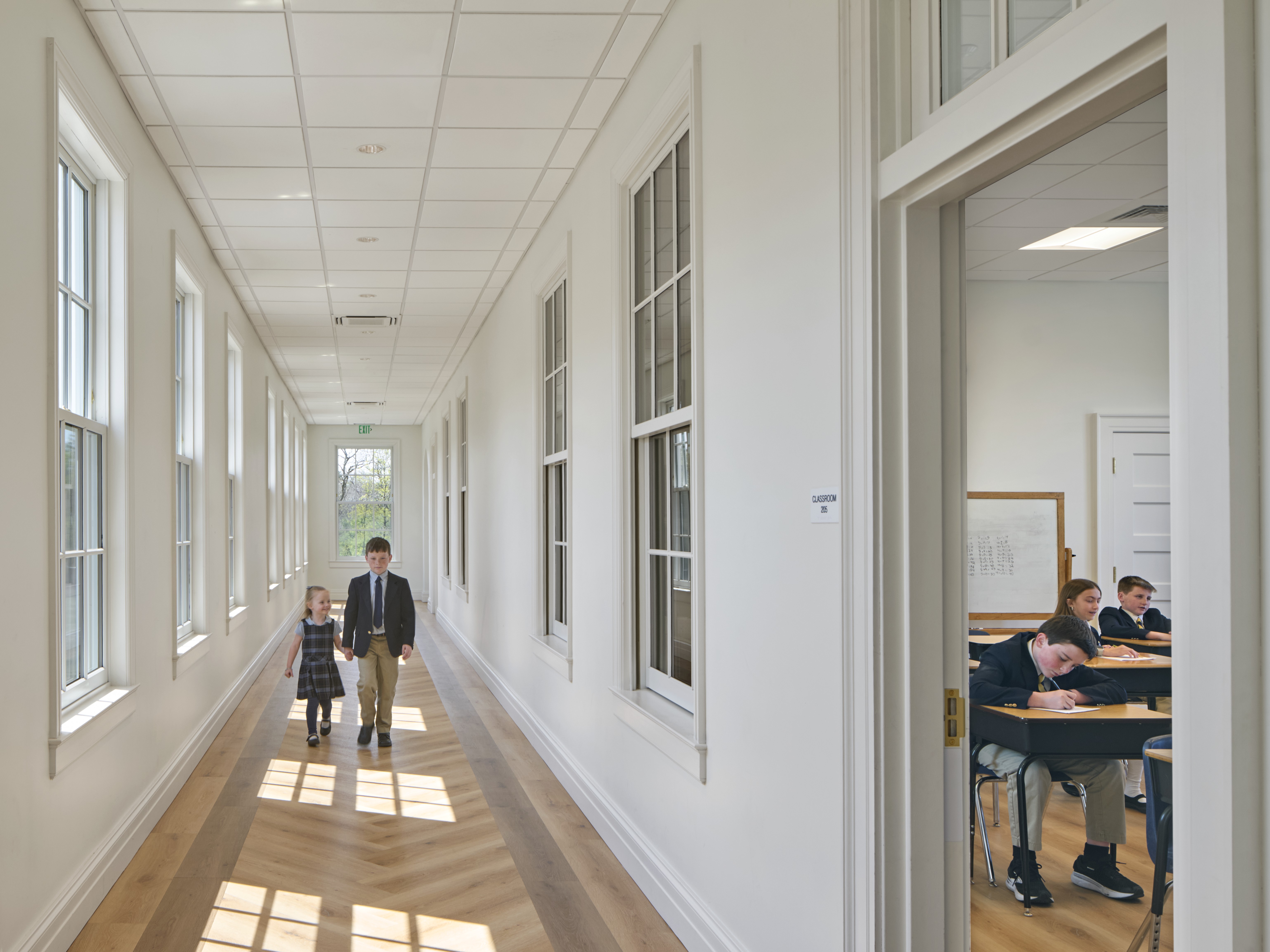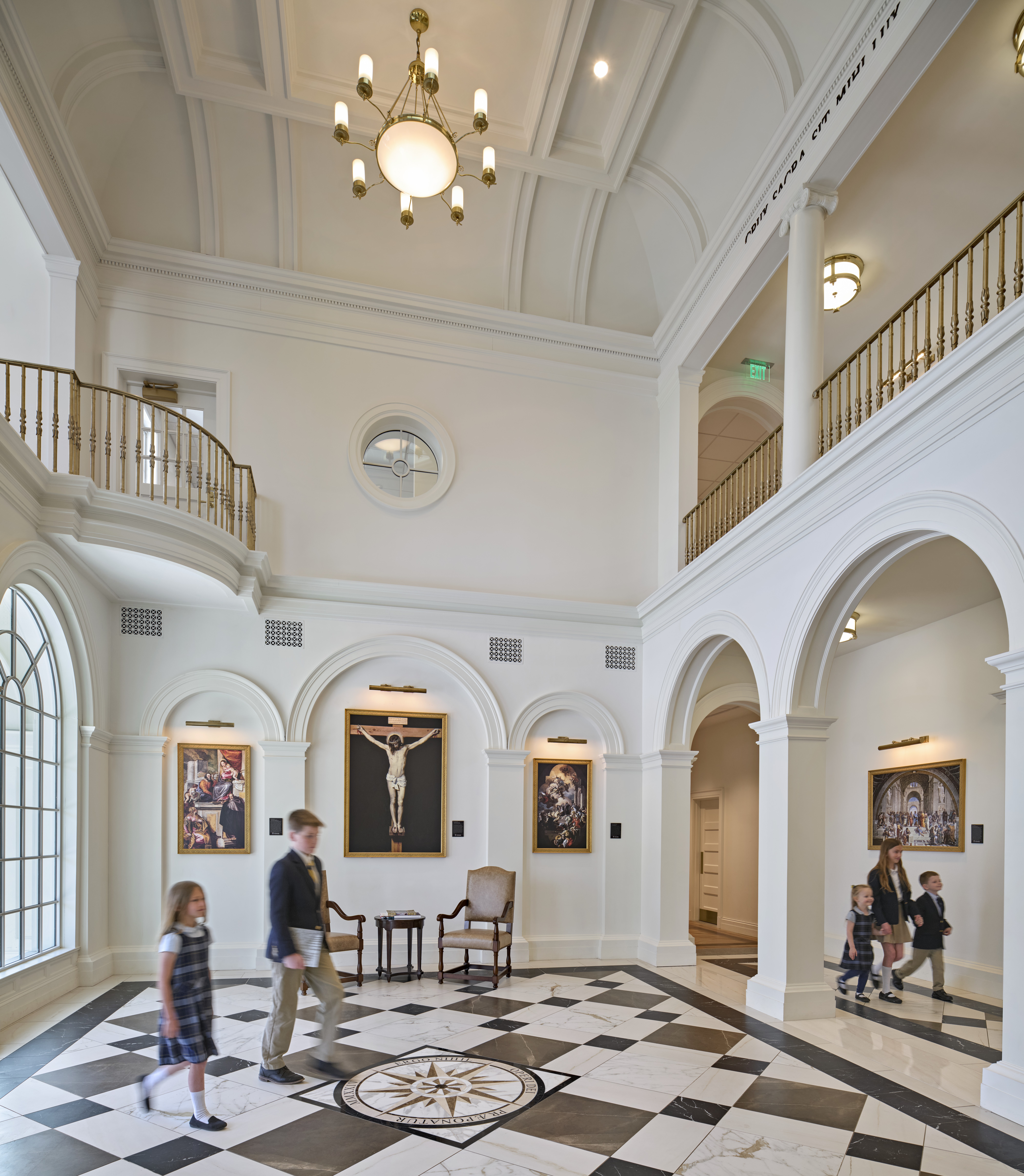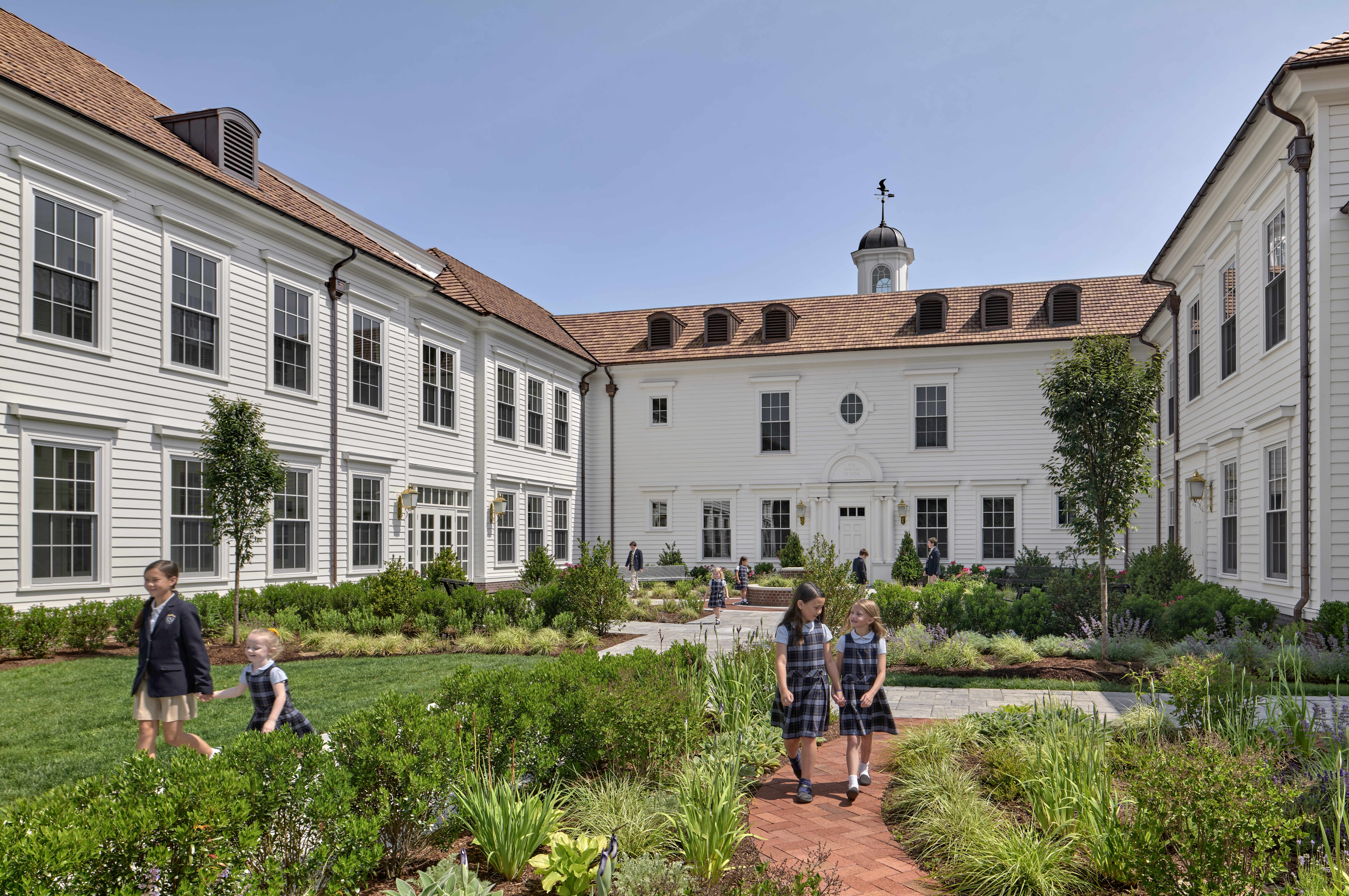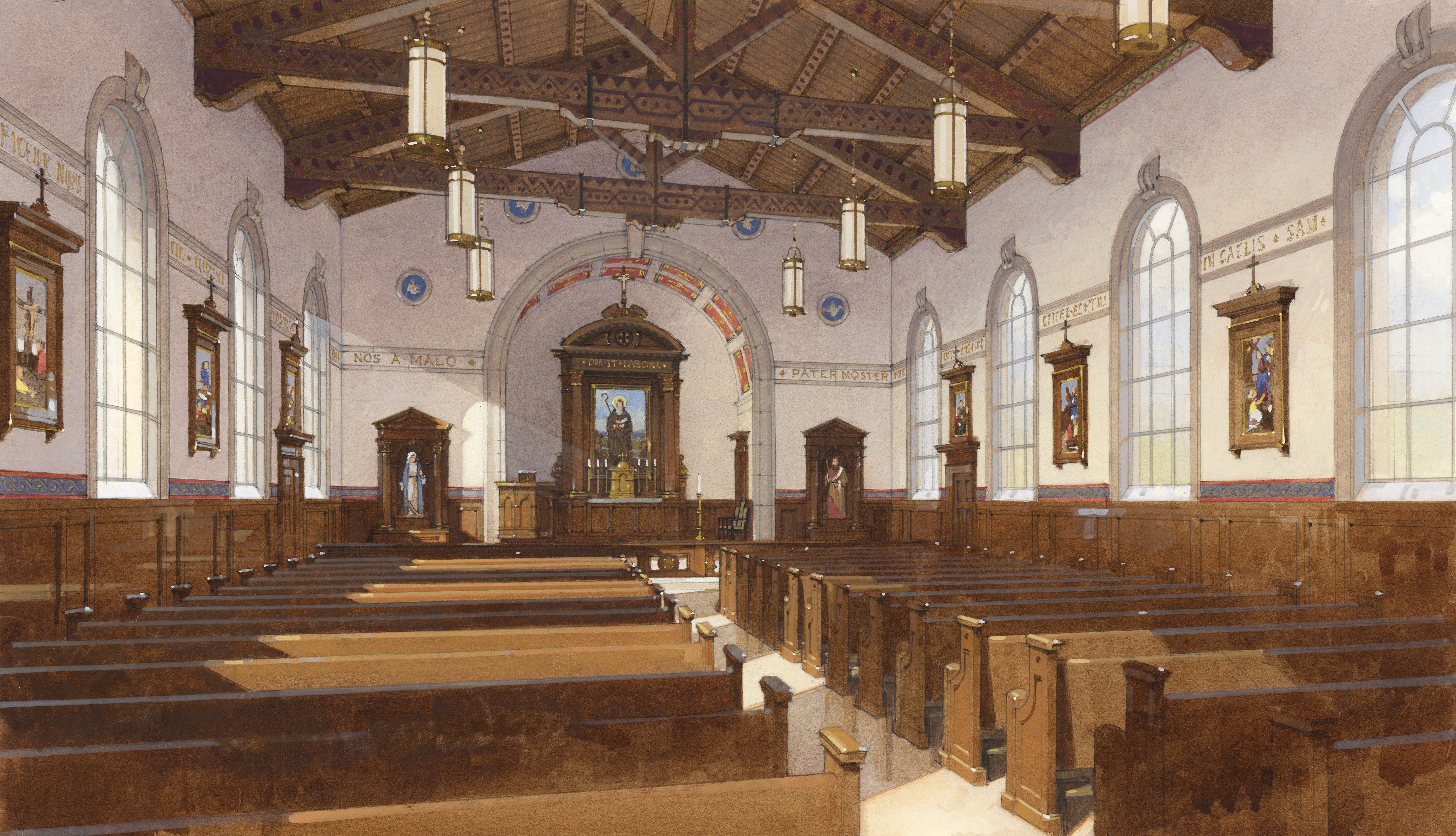St. Benedict Classical Academy’s Classical Architecture| National Catholic Register
The headmaster of St. Benedict Classical Academy (SBCA), an independent Catholic school in Natick, Massachusetts, often says that architecture is a student’s first teacher.
Jay Boren was so convinced of the formative power of a school’s physical space that, five years ago, he launched an ambitious project — which ultimately cost $20 million — to create a new pre-K-to-grade 8 school building.
The building was meant to reflect SBCA’s mission to offer a classical Catholic education that cultivates “intellectual and moral virtue in a joyful, Christ-centered environment, rooted in the riches of Catholic magisterial teaching as defined by the Catechism of the Catholic Church,” according to the school’s website.
Rooted in the Catholic intellectual tradition, SBCA’s curriculum draws on the foundations of Western civilization. In kindergarten, the students are introduced to Latin and begin conjugating verbs in third grade. And all students receive instruction in the art of public speaking.
Completed last December, the campus welcomed students midway through the academic year. As the school begins its first full year in the new space, the building stands as a physical expression of the beauty, order and tradition that define its mission.
The new building, designed on the principles of classical architecture, is nothing short of stunning. Its symmetrical façade, portico, arches and Ionic columns blend beautifully with its Colonial-era white-clapboard exterior, making it feel perfectly at home in its New England setting.
“The children understand that if they’re going to school in a building that looks like this, it must be important,” Boren told the Register.
Boren says he has already seen the fruits of the new school building.
For one thing, there are waiting lists in almost every grade. This year, 365 students have enrolled in the school — that’s up from the 45 pupils who attended when Boren arrived 10 years ago.
He said the design of the building, its symmetry, high ceilings and light-filled rooms impact students even if they are not quite aware of it.
“There’s balance and there’s order that naturally draws their hearts and minds to God,” Boren said.
“What needs to be the hallmark of our school is a faithful joy. We want people to look and say, ‘Why are those people so happy,’” he said. “This building is able to articulate that in its own architecture. It’s just so beautiful.”
Nicolas Charbonneau, the architect who designed the school building, explained to the Register that buildings built on the principles of classical architecture are so beautiful to look at in part because they are in harmony with the natural world. They are built according to the design of the human body and the way we perceive the world around us.
“The idea is that when we’re looking at a building it appears that it should
be standing up on its own two feet, so to speak, and that any of the elements that we’re looking at convey the fact that this is responding to our natural understanding of physics,” explained Charbonneau, principal and partner of Sacred Architecture Studio at Harrison Design.
Similarly, Charbonneau said, in classical architecture, the whole relates to the parts, in the same way that the whole body is proportionally related to its parts, as illustrated by Leonardo da Vinci’s Vitruvian Man drawing.
In classical architecture, every part of an edifice, built according to classical principles, was designed to be in proportion to the whole.

“All those elements within it — the base, the diameter of the column shaft, the capital, all the bits and pieces of the entablature [superstructure of moldings] — those all had a ratio where it’s in proportion to each other,” Charbonneau explained.
“No matter if it was a very large or a very small piece, all those components had some rational proportion to them,” Charbonneau added.
“That was the ancient understanding of the human body. Then the architecture should reflect that as well. If we understand the human body as being created in the image and likeness of God, we’re just reflecting the way that God has created the human person.”
“There should be some reflection of the intent of the design of the human body in the buildings that those beings inhabit,” he said.
A philosophy major as an undergraduate at Anna Maria College in Massachusetts, Charbonneau fell in love with classical architecture while participating in a study-abroad program in Rome.
“I just had no idea that it could be just so magnificent,” he said, describing walking into St. Peter’s Basilica as an “otherworldly experience.”
“That was really the intent, right? It was to make something so magnificent that it’s a reflection of the glory of God,” Charbonneau added.
Upon his return to the United States, he pursued a career in construction and then enrolled in a graduate program in architecture, only to discover that the kind of architecture he loved was looked upon with disdain.
“They would say things like, ‘That looks like that’s from the Renaissance,’” explaining, “The Renaissance is a pejorative term in design schools these days.”
Charbonneau said that the design for St. Benedict’s Classical Academy would probably be seen as “derivative” by some people part of what he calls “the prevailing architectural educational culture.”
He went on to study classical architecture at the University of Notre Dame, under Thomas Gordon Smith, the founder of the program, and Duncan Stroik, who he calls “the king of classical sacred architecture.”
At Notre Dame, he found exactly what he wanted to study.
“I don’t frankly care about the arguments against employing the classical forms,” he said.
“I think that they’re so rooted in some of the fundamental principles of who we are as human beings, but also the way it fits within Western civilization. I think there’s no reason not to do it,” he said.
At St. Benedict’s, the principles of classical architecture are most apparent in the school’s grand entry hall, which Charbonneau says is “the finest room in the building.”

The eyes are drawn upward to the coffered ceilings, ornate chandeliers and sacred art decorating the walls. The diffused light from the cupola is an apt metaphor, Charbonneau says, for the “light of the intellect that comes from our Creator.”
“It provides student, teacher and visitor with a sense of the great undertaking that is classical education,” he said.
Boren, too, sees the entry hall as the space that best articulates the mission of St. Benedict’s.
“It’s really the hallmark of the school. It’s just beautiful,” he said.

The headmaster is also particularly proud of what makes the school uniquely Catholic: the flower garden, where students go to pray the Rosary and to read. The headmaster is currently engaged in raising money for the next stage of the building: St. Benedict’s chapel, also designed by Charbonneau’s firm.

At the end of the day, though, it’s the community — not the building — that makes the school, according to Boren.
The first priority, he said, is to raise money each year to make the school affordable. The school offers $1.3 million a year in financial aid and keeps the tuition at a little over $13,000, far less than most private schools in the area charge.
Even that is a “real struggle” for some families, he said. “But those families keep the culture of the school what it is; it’s really important for them to be able to come here.”
Many families, he said, are driving up to an hour and a half to get to St. Benedict’s (one family comes from as far away as Rhode Island), which Boren said is “really remarkable and humbling.”
He added: “They’re coming to us for our mission and so we have to deliver the misson. It’s really important.”

